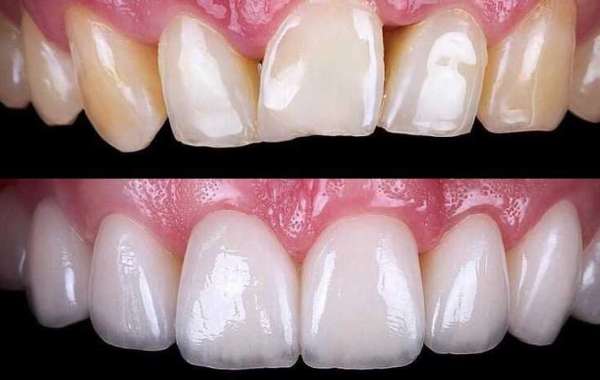Those who are self-conscious about their smiles might inquire about porcelain veneers from a cosmetic dentist. Veneers are wafer-thin shells made of porcelain teeth veneers that are bonded to the fronts of your teeth by your dentist so that you can smile with confidence.
Dental veneers may be an option for you if you have minor cosmetic damage to your teeth that are visible when you smile or talk. If you have a chipped tooth, your dentist may suggest dental veneers as a solution. Learn why you should inquire about the porcelain teeth veneer technique in the following paragraphs.
What Are Veneers?
In order to improve the aesthetics of teeth, thin, tooth-colored shells called dental veneers are bonded to the front surfaces of the teeth. Permanently attached to your teeth, porcelain teeth veneers or resin composites are the most common materials used to create dentures.
Tooth discoloration, chipped, damaged, or smaller-than-average teeth can all be improved with veneers.
The number of veneers needed varies from person to person, but most people need between six and eight veneers to achieve a uniform, symmetrical smile. Veneers are most often put to the upper front eight teeth.
Why Dental Veneers Are The Best Option For Transforming Your Smile
With just a few visits to the dentist, dental veneers may convert any smile into a show-stopping one. The following are some good reasons to consider dental veneers when trying to improve the appearance of your smile.
Improve Tooth Shape
Tooth anomalies are common in some persons. It could be misshapen or considerably smaller than the rest. A veneer might be used to conceal the affected teeth for those who are dealing with it. Patients can have a prosthetic tooth that matches the rest of their teeth and no one will know that they've had a veneer put on a tooth.
Dental Veneers Solve Cosmetic Issues Quickly
There are numerous procedures available in the realm of cosmetic dentistry that can correct abnormalities such as misaligned teeth, gaps between teeth, and uneven surfaces. However, orthodontic treatment is usually required to realign the teeth. And these kinds of operations can take a long time. In addition, they tend to cause a lot of discomfort during the procedure.
Dental veneers are a more straightforward option. Instead of addressing the underlying structural concerns, they build a beautiful facade to hide them from view. Even if irregularities in your teeth's surfaces or gaps between them aren't harmful to your oral health, there's no need to correct them. There is no denying that veneers are a time-saving alternative to other cosmetic operations.
Dental Veneers Fill up Gaps, Chips, and Cracks in Your Teeth
Bonding is a typical process for correcting tiny flaws in your teeth, such as gaps, chips, or cracks. Using a tooth-colored resin, you can repair the damage and restore a faultless appearance. Instead of bonding, dental veneers are an excellent alternative. Veneers made of porcelain, rather than resin, are more long-lasting and don't need to be retouched or adjusted over time.
Natural Appearance and Feeling
Porcelain teeth veneers are custom-made to match the color and luster of your teeth. Impression of your teeth will be taken at your initial visit to the dentist. Your veneers will be fabricated in a dental laboratory using the impressions you provide. Your dentist will make minor modifications to the color and fit of your veneers when you return to the dental office. Porcelain veneers, unlike other types of dental covers, appear and feel like natural teeth.
Minimal Adverse Effects
Porcelain teeth veneers don't necessitate as much tooth enamel removal as other types of restorative dentistry. When compared to dental crowns, porcelain veneers allow patients to retain more of their natural teeth.
Veneers are thin shells of porcelain cemented to the front surfaces of teeth. On the other hand, because dental crowns cover the entire tooth, your dentist will have to remove more enamel to make them fit. Since getting veneers doesn't hurt you, you might not even need to be numbed while your dentist takes off some enamel.
Inconveniently Low-Maintenance
Veneers should be treated much like natural teeth. Plaque can be removed by brushing twice a day and flossing once a day. Also, remember to visit your dentist on a regular basis for cleanings and exams. Maintaining your veneers in pristine condition is as simple as following these simple instructions. Dental veneers are more stain and cavity resistant than natural tooth enamel because they are non-porous. Veneers can be maintained with minimal effort.
Durable
Porcelain teeth veneers can be damaged by eating hard things, such as ice. You may anticipate your veneers to last at least a decade if they are well-maintained. Do not use your front teeth to chew on or eat anything that is hard.
Disinfectant Resistant
Because they are stain-resistant, you can eat whatever you want with no fear of staining your veneers. On the other hand, veneers must be cared for in the same way as natural teeth. Veneers can become discolored if you consume an excessive amount of coffee, and unlike natural teeth, veneers cannot be bleached.
Dental Health Benefits
Toxic substances might irritate your gums. A gum-safe material is used in the creation of veneers, so they are a good match for your teeth and gums. You don't have to be concerned about the long-term effects of veneers on your gum health.
What Is The Procedure For Applying Dental Veneers?
After your dentist develops your mold, it usually takes 1 to 2 weeks for the lab to get back to you with your veneers.
Your appointment to have your veneers installed can be scheduled once you have received your veneers. After a thorough examination by a dental professional, your veneers will be fitted and color-coordinated to ensure they fit perfectly.
Next, your dentist does a complete dental cleaning on you. In order to avoid degradation, germs must not be able to hide behind the veneer.
Then, with the grinding tool, they roughen up the surface of each tooth to be veneered. This helps the veneer adhere to the tooth.
The dental cement used by your dentist to attach the veneer to your tooth is called dental cement. To hasten the hardening process, ultraviolet light will be employed.
The second session, where veneers are applied, normally lasts no more than two hours. However, this may differ if a local anesthetic is utilized or if many veneers are being placed.
How To Look After Your Veneers Once They've Been Installed
The recovery period is much shorter than with other types of dental work. If you have veneers put on, you can eat and drink normally as soon as the anesthetics have worn off. Avoid biting on your cheeks or tongue while the anesthesia is kicking in since this could lead to complications.
You may notice that the veneers are a little harsh just after they are put in some circumstances. After a few days of normal eating and brushing, these rough patches (typically from excess cement that can attach to the veneer) wear away. In the event that they don't, your dentist will be able to help.
Some research suggests that traditional porcelain tooth veneers can last up to 20 years, while no-prep veneers normally last between 5 and 7 years. You can extend their life expectancy by following a few simple guidelines.
However, if you want to check the prices or specifications of the latest Tecno, Infinix, and Huawei phones, then a reverse image search tool is the best option. This tool helps you find all the latest mobiles at Franko Trading Enterprise with the help of an image, keyword, or URL.
References:
1-The Success of Dental Veneers According To Preparation Design and Material Type
Published online 2018 Dec 14.
DOI:10.3889/oamjms.2018.353
2-Influence of symmetry and balance on visual perception of a white female smile
Available online 10 October 2018, Version of Record 10 October 2018.
https://doi.org/10.1016/j.prosdent.2018.05.008
3-Features of fracture of prosthetic tooth-end crown constructions by means of acoustic emission analysis
Received 21 April 2017, Revised 7 December 2017, Accepted 16 January 2018, Available online 15 February 2018, Version of Record 15 February 2018.
https://doi.org/10.1016/j.dental.2018.01.023










